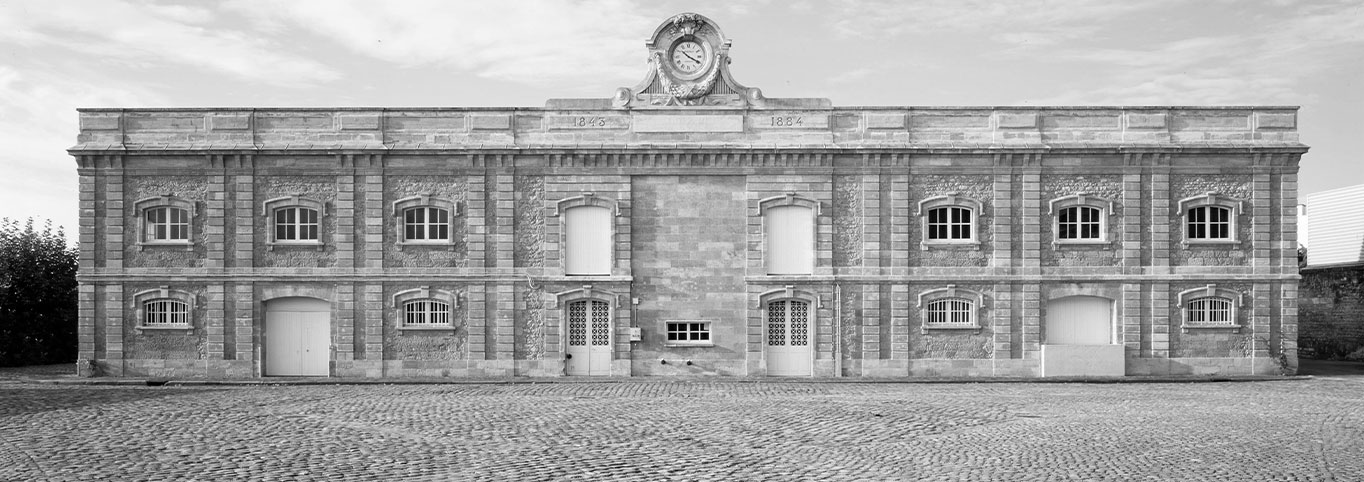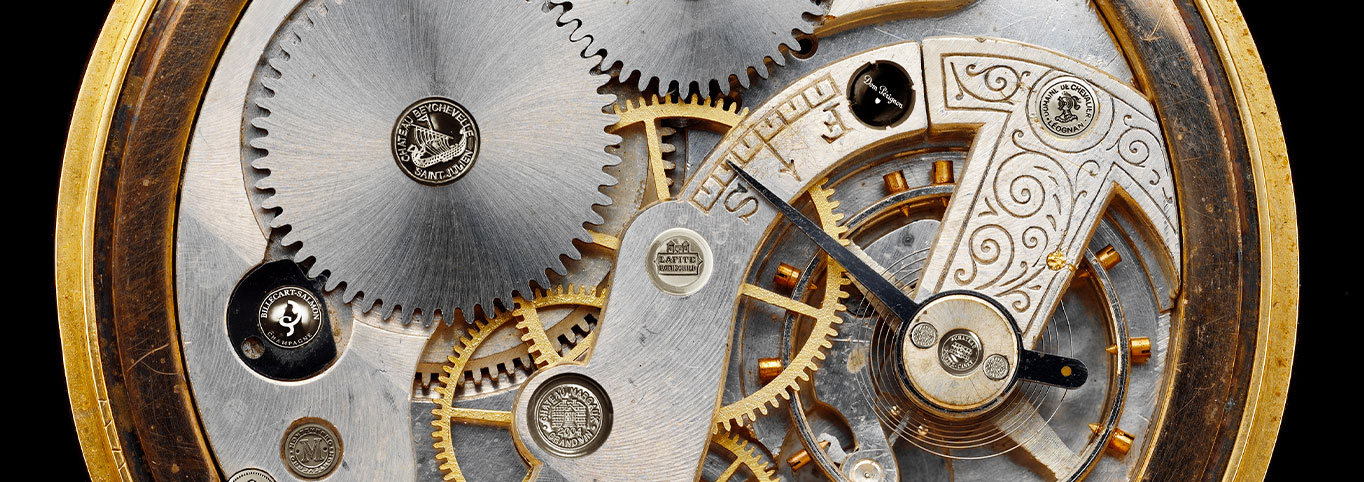THE CELLARS, THE HEART OF MILLESIMA

The heart of Millésima lies just a stone’s throw from the Saint- Jean train station in Bordeaux, on the left bank of the Garonne river. Over two and a half million bottles are stored in the Paludate cellars, along with a unique collection of 12,000 unusually sized bottles held in the Imperial Library, carefully selected and lovingly cared for while awaiting dispatch.
The Paludate cellars have recently rediscovered a level of activity that it hasn’t
experienced since the 1970’s, when Lucien Bernard & Cie left for Ambès, on
the other side of the Garonne. Major works were begun in 2016, with the aim of
increasing storage space as well as accommodating the company’s employees and
the entire Bernard Group in a new building that will feature 4,000 m2 of office
space: a substantial real estate operation!
This renovation also coincides with the Bordeaux-Euratlantique project, an
initiative aimed at developing this part of the city and giving it a new lease of life:
with a Europe-wide remit, in addition to extending the station, the development
includes landscaping open spaces overlooking the river, creating engineering
works, offices and housing, as well as reshaping the road infrastructure following
the construction of the Simone-Veil Bridge.

The history of the Paludate wine cellars dates back to the middle of the 19th century, when a Prussian wine merchant set up business in Bordeaux: J.-J. Muller, from Nordhausen, in the province of Saxony, teamed up with a man named Richard, who we know nothing about today, to create Richard and Muller enterprises. When the company became a public limited company in 1903, it had been in business for 50 years, meaning that it was founded in 1853. The 1860 Annuaire général du commerce et de l’industrie also notes the existence of the «Richard and Muller wine merchant», located at 35-37 quai de Paludate - while number 86 was occupied by a lime refiner named Valette.
The choice of location was unusual: at that time, wine merchants were usually based further north, on the Quai des Chartrons. Richard and Muller no doubt believed that this location would give them a competitive advantage. It was around this time that the Compagnie des chemins de fer du Midi began the construction of a railway line linking Bordeaux to Sète and the Paludate lowlands were chosen as the site for the future Saint-Jean Station. Constructed - from wood! - in 1855, the Gare du Midi, as it was fi rst known, found itself in competition with the Bordeaux- Bastide station on the right bank. But after the Eiffel railway bridge linking the two stations was completed, it became Bordeaux’s main train station in the early 1860s.
During this period the Richard and Muller company prospered. Oddly enough, it’s not clear whether the company was a wholesale wine merchant or a distillery, or both at the same time - the records often contradict each other on this point. What we do know though, is that there’s an undeniable coincidence in this story: the Richard and Muller company, which came from the East (Saxony), was both a distillery in the Bastide and a wine merchant on the Quai de Paludate. There is an interesting parallel with the Bernard group, the current owners, who come from the North (Lille), who were also distillers in the Bastide from 1928 to 2000, and who are now wine merchants at 87 quai de Paludate.

We also know from the archives that the Richard and Muller company was involved in illegally counterfeiting cognac. In October 1876, Le Figaro reported the counterfeiting lawsuits brought against Richard and Muller, as well as Jean- Louis Martell, by the company Martell & Cie (J.F. Martell). The 1877 Annales de la propriété industrielle, artistique et littéraire reveals that «having been convicted in 1874 for competing unfairly against J. F. Martell, by using the name and trademark of Martel de Valros, they [Mr. Richard and Mr. Muller] succeeded in continuing this fraudulent activity by procuring the name and assistance of J. F. Martell, who due to his bankruptcy and loss of credit was unable to trade himself.” Jean-Louis Martell’s role in these activities was a minor one: he merely received goods sent by intermediaries hired by Richard and Muller and re-dispatched them, using the name Martell and a label that was very (too!) similar to that of the prestigious Martell brand.
Despite the scandal and the ensuing lawsuit, the Richard and Muller enterprises continued to grow and prosper. The resulting growth in business led to repeated expansion. A large building at 87 quai de Paludate was constructed in 1884. In April, a request for permission to build large cellars, accompanied by plans and a drawing of the site on Marc Promis Street (rue de Son-Tay), was submitted by Richard and Muller to the mayor of Bordeaux, who approved the works.

The Muller family fame is largely due to Fernand Muller, the son of the founder
of the company. A naturalized French citizen and an accomplished fencer (!), he
became the consul for Austria-Hungary in 1902.
At this point, the story takes a dramatic turn. In 1903 Fernand Muller married
Pauline Moiriat, a very young music-hall singer whose stage name was Marcelle
Gay. They had met while she was performing at a concert in Quinconces. But
Fernand died a year later aged just 50, on 13 April 1904. The French weekly
magazine ‘Détective’ reported this event in its 12 February 1931 issue, with all the
journalistic objectivity you would expect: “The husband died suddenly, overcome,
it was said, by an embolism. Malicious rumours circulated at the time. There was
talk of “bad coffee”. By a strange coincidence, their beautiful St. Bernard dog
died a few hours after his master. According to another version, which was also
rumoured at the time, Muller surprised his young wife with a lover, (...) and the
shock struck him down.
But perhaps we should think of all this as nothing more than nasty insinuations.
No legal action was taken and the widow, having thanked the servants the day
after the funeral, left the house where the seals were affixed. After some inevitable
difficulties caused by the family of the deceased, Mrs. Muller was able to take
possession of the substantial fortune bequeathed to her by her short-lived husband
in his last will and testament..
This inheritance became the fortune of a certain Paul-Marie Bolo, whom the
young woman met in November 1904 and married in May of the following year.
Taking advantage of a power of attorney lovingly granted by the widow, this young
adventurer embarked on a lavish yet risky lifestyle, even becoming the financial
adviser to the Khedive of Egypt in 1914, who made him a Pasha! Paul-Marie Bolo,
who called himself «Bolo Pacha», was later implicated in financial manipulation
involving Deutsche Bank and sentenced to death for treason.
In an interview with Le Petit Parisien, featured in the 3rd December issue, Muller’s widow, then Mrs. Bolo, spoke to Maurice Prax: “ ‘Yes, I was a singer. I was 18 years old. Is it disgraceful to have be an artist? I’ve never been ashamed of it. (...) My marriage to Mr. Muller was a joint estate, so there was nothing mysterious about my inheritance. (...) He was always a wonderful husband. I treasure my memories of him and I never pass through Bordeaux without visiting his grave... He died on 13th April 1904. I met Bolo on 11th November that same year. We were married on 15th May 1905...’ (...) Mrs. Bolo stopped, overcome with emotion. She took a cigarette out of a silver case. But instead of lighting it she said: ‘The pasha! What tales have been told about his fancy lifestyle, his trips, his adventures, his gambling in casinos or clubs!... But Bolo never left me... (...) Mrs. Bolo stopped, a little out of breath. She frowned. ‘You see sir,’ she said - her voice trembling - ‘you see, we made a grave mistake, my husband and I! We were too happy... And you could see our happiness... You could see it in our eyes... We are being made to pay dearly for that today... ” Bolo was executed on 17th April 1918 at Vincennes Fort.
After the death of Fernand Muller, the Richard and Muller company continued under the management of Georges Krippléber and Léon Bernex. The company’s strategy seemed particularly focused on exports, as evidenced by references in Franco-British publications and advertisements relating to Richard and Muller supplying wines to the French colonies.

The First World War is thought to have had a negative impact on Richard and Muller, with the Paludate cellars being sold in the 1920s. They were acquired by a grocer named Julien Damoy, whose business was expanding rapidly at the time. Having first set up business in Paris during the Belle Époque, Julien Damoy gradually expanded his wine and general grocery business to cover the whole of France. The owner of vineyards in Beaujolais, in Romanèche-Thorins and in Gevrey-Chambertin, he jointly purchased 87 quai de Paludate and numerous wine estates in the region, such as Château La Tour de By in the Médoc. Le Sommelier magazine, dated 15th May 1925, lists Julien Damoy as one of the buyers of the 1924 harvest of Bordeaux’s grands crus.
The Damoy company vacated the cellars at 87 quai de Paludate shortly after the Second World War. In 1959, after a few years of disuse, they became the property of Lucien Bernard et Cie, who decided to use them to age his brandies. And so another chapter in the story began...

